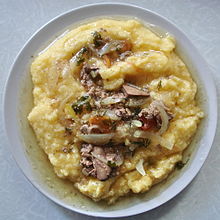Liver (food)



The liver of mammals, fowl, and fish is commonly eaten as food by humans (see offal). Pork, lamb, veal, beef, chicken, goose, and cod livers are widely available from butchers and supermarkets while stingray and burbot livers are common in some European countries.
Nutrition
| Nutritional value per 100 g (3.5 oz) | |
|---|---|
| Energy | 561 kJ (134 kcal) |
2.5 g | |
3.7 g | |
21 g | |
Niacin (B3) | 94% 15 mg |
| Vitamin B6 | 41% 0.7 mg |
| Folate (B9) | 53% 212 μg |
| Vitamin B12 | 1083% 26 μg |
| Vitamin C | 26% 23 mg |
| Minerals | Quantity %DV† |
| Iron | 128% 23 mg |
| Sodium | 4% 87 mg |
This nutritional data is from 1992 and refers to raw pork liver only. Liver nutrients vary among species. | |
| †Percentages estimated using US recommendations for adults,[1] except for potassium, which is estimated based on expert recommendation from the National Academies.[2] | |
Animal
Etymology
From Middle English liver, from Old English lifer, from Proto-Germanic *librō, from Proto-Indo-European *leyp- "to smear, smudge, stick", from Proto-Indo-European *ley- "to be slimy, be sticky, glide". Cognate with Saterland Frisian Lieuwer "liver", West Frisian lever "liver", Dutch lever "liver", German Leber "liver", Danish , Norwegian and Swedish language lever "liver" the last three from Old Norse lifr "liver".
In the
Preparation
Liver can be baked, boiled, broiled, fried,
Fish liver
Some fish livers are valued as food, especially the stingray liver. It is used to prepare delicacies, such as poached skate liver on toast in England,[8] as well as the beignets de foie de raie and foie de raie en croute in French cuisine.[9] Cod liver (usually tinned in its oil and served seasoned) is a popular spread for bread or toast in several European countries. In Russia, it is served with potatoes. Cod liver oil is commonly used as a dietary supplement. Liver of burbot is eaten in Finland: it is common for fish vendors and supermarket fish aisles to sell these fish with liver and roe sacks still attached. These parts are often eaten boiled or added to burbot soup. Burbot and its liver are a traditional winter food.[10]
Poisoning
The livers of polar bears, walruses, bearded seals, and huskies can contain very high levels of preformed vitamin A,[11] and their consumption has led to vitamin A poisoning (hypervitaminosis A) according to several anecdotal reports. The Inuit will not eat the liver of polar bears or bearded seals. It has been estimated that consumption of 500 grams of polar bear liver would result in a toxic dose for a human.[11] Russian sailor Alexander Konrad, who accompanied explorer Valerian Albanov in a tragic ordeal over the Arctic ice in 1912, wrote about the awful effects of consuming polar bear liver.[12] Also, in 1913, Antarctic explorers on the Far Eastern Party Douglas Mawson and Xavier Mertz were believed to have been poisoned, the latter fatally, from eating husky liver, though this claim has been recently contested.[13]
Mercury content in some species can also be an issue. In 2012, the Government of Nunavut, Canada warned pregnant women to lower their intake of ringed seal liver due to elevated levels of mercury.[14]
The
Traditions
Pig liver is a traditional food of immigrant Okinawans in Hawaii. It used to be eaten on New Year's Eve.[15]
References
- ^ United States Food and Drug Administration (2024). "Daily Value on the Nutrition and Supplement Facts Labels". Retrieved 2024-03-28.
- )
- PMID 7477116.
- ^ "Vitamin A". oregonstate.edu. Linus Pauling Institute. 22 April 2014. Retrieved March 30, 2020.
- ^ Nährstoffe und Vitamine in Dorschleber Deutsches Ernährungsberatungs- und -informationsnetz (in German)
- S2CID 28688784.
- ^ "Foie". Larousse.fr. Retrieved 2019-04-16.
- ^ Dods, Margaret (1837). The Cook and Housewife's Manual ... The fifth edition, revised and enlarged, etc (Sixth ed.). Oliver & Boyd, Eninburgh. p. 269. Retrieved 13 February 2018.
- ISBN 978-0813911625. Retrieved 12 February 2018.
- ^ "Kalakoulu: Made". 28 February 2011.
- ^ PMID 16747610.
- ^ Valerian Albanov. In the Land of White Death. Appendix; A. Konrad's notes.
- S2CID 8430414
- ^ Canada, Environment and Climate Change (2020-07-03). "4. Mercury and Human Health". aem. Retrieved 2020-10-27.
- ^ Ethnic Foods of Hawaiʻi page 80


